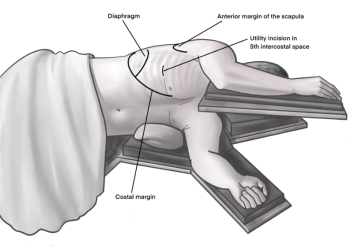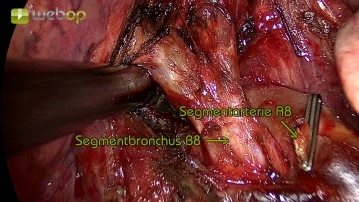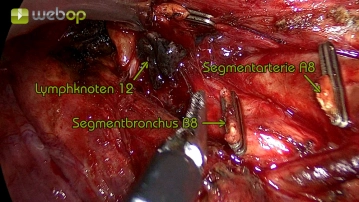Incision of approximately 4 cm in length in the area of the anterior axillary line at the upper edge of the 5th rib to access the 4th intercostal space above. A helpful orientation is often an imaginary line from the tip of the scapula to the nipple. Transection of the subcutis on the rib with the monopolar knife. Subsequently, stepwise preparation of the intercostal muscles with the monopolar knife. The pleura is opened bluntly with a finger. Palpation of the thoracic wall for adhesions and insertion of a wound protection film.
-
Access uniportal VATS right
![Access uniportal VATS right]()
-
Preparation of the interlobium
![Preparation of the interlobium]()
Soundsettings First, the operation begins with the exposure of the interlobar part of the pulmonary artery. For this, the parenchymal bridge between the upper and middle lobes is prepared using an ultrasonic scalpel. A large lymph node from station 11 is retrieved in the process.
Tip: In anatomical resection, the sequence of surgical steps can vary depending on the intraoperative situation.
-
Dissection of the segmental artery A8
![Dissection of the segmental artery A8]()
Soundsettings The circular presentation of the pars interlobaris of the pulmonary artery is performed. The depiction of the branches to the middle lobe (segmental arteries A4&A5) is omitted if the vessels clearly run into the lower lobe. The segmental artery A8 is now presented circularly and bluntly encircled. This is followed by traction using Vicryl ligature, placement of titanium clips, and dissection with the ultrasonic scissors.
-
Resection of the segmental bronchus B8
![Resection of the segmental bronchus B8]()
Soundsettings The bronchial system typically runs slightly offset from the branches of the pulmonary arteries. Therefore, after severing the segmental artery A8, the view of the segmental bronchus B8, here with an early division into the subsegments B8a and B8b, is clear. Blunt dissection is performed again until encircling and ligating with a Vicryl suture is possible. Then, a titanium clip is placed centrally, and sharp transection with scissors is performed to avoid thermal damage to the segmental bronchus stump.
-
Lymph node dissection station 12
-
Preparation of the pulmonary ligament and visualization of the inferior pulmonary vein
![Preparation of the pulmonary ligament and visualization of the inferior pulmonary vein]()
Soundsettings The pulmonary ligament is formed by the union of the two pleural layers (visceral and parietal pleura). Dissection of the pulmonary ligament is performed with the ultrasonic scissors close to the lung parenchyma until partial exposure of the inferior pulmonary vein.
Subsequently, the circular exposure of the inferior pulmonary vein and the first division into typically a large-caliber branch of the 10th segment and a common venous branch V6-9 is performed, mostly by blunt dissection and pushing aside of the adhering tissue.
Tip: The dissection of the pulmonary ligament is not only helpful for better mobility of the lung and thus facilitates the operation. Postoperatively, better mobility of the remaining lung can also improve the "filling" of the thoracic cavity after a resection.
-
Preparation and transection of the segmental artery A7
Here too, the course of the artery can be used to identify and display the analogous course of the
Activate now and continue learning straight away.
Single Access
Activation of this course for 3 days.
Most popular offer
webop - Savings Flex
Combine our learning modules flexibly and save up to 50%.
US$51.56/ yearly payment
thoracic
Unlock all courses in this module.
US$103.10 / yearly payment








